Most Expensive Cat Breed in the World Bengal Zeus - Esmond Gay
Let me introduce you to the magnificent F1 Bengal cat, Sarez Zeus, who was bred by British breeder, Esmond Gay of Sarez Bengals. Zeus is the world's most expensive cat and sold for $150,000 (£100,000) in 2003. Esmond is, in my opinion, one of the foremost authoritative figures on the Bengal cat, a man who can accurately describe them, their history and the experience of living with them and their wild ancestors.
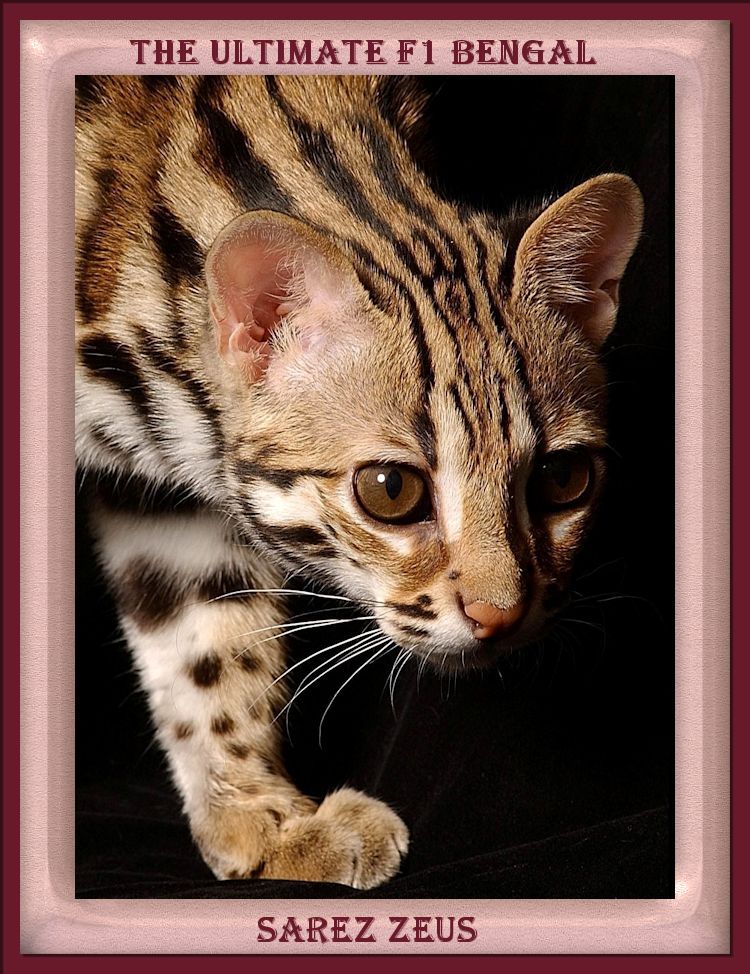
Esmond and I became firm friends after he came across a page I had written about him and his work on this site (see the left hand menu). At the time of writing it, I didn't know him, but had read so much about him and was fascinated by his passion for cats. It was clear that Esmond has a heart of gold and I felt that my love for Lucy is so similar to his love for his cats, and so to me, creating that page suited my website perfectly. Throughout his career, Esmond wrote numerous, incredibly informative articles about his cats and work, and I'm proud that I'm able to share these breeding stories, photos and other links with the world (click the coloured hyperlinks on this page to read any of Esmond's articles).
But one of his cats intrigued me more than any other; Sarez Zeus! And so I decided to create a new page dedicated to this beautiful little cat and his forebears. I wanted to express my thoughts and feelings about him, as well as including some of Esmond's most descriptive quotes from his articles. And I added some interesting information about early generation Bengals as well. I hope you enjoy it!
The photographs on this page are beautiful and most have never been seen before and are nowhere else on the internet, so it's an honour to be able to display them here. But they are the property of Esmond and a lot of work went in to taking them, so I kindly ask you not to copy them. If you would like to use any, please email me and I'll get permission.
Note; If you're just interested in general information about the Bengal cat rather than early generations as described on this page, then this article, written by Esmond, is a good read as it describes the history of the Bengal, their physical characteristics, the various colours and generations, and what its like living with them:
'A Guide to the Magnificent Bengal Cat'. To read it, please click HERE.
And if it's just information on Esmond and the spectacular breakthroughs he made in the Bengal fancy that you're interested in, then this very personal article describes it all far better than I can; from his traumatic early years and the comfort he gained from his cats, to how his 'rags to riches' tale played out:
'Sarez Bengals - Our Story'. To read it, please click HERE.
But I will explain how and why Esmond created the magnificent Zeus. In 1993, Esmond was drawn to Bengals due his love of wild cats. Until the latter half of the 1990s, his life and circumstances prohibited the keeping of such wild animals, and so the Bengal breed was an obvious compromise...that is, until he bought a large estate and could accommodate them properly. His article 'The Sarez Wild Cat Conservation Programme'. explains all this, and describes life with his ocelots, African leopards and other wild cats.
'The Sarez Wild Cat Conservation Programme'. To read it, please click HERE.
Esmond's adoration for the Bengal breed and his perfectionist attitude produced many amazing cats, but in the early years, one if his most famous was Sarez Cato, a magnificent F2 Bengal who in 1998, entered the Guinness World Records as the world's most expensive cat when he was sold to famed socialite, Cindy Jackson for $41,435.00 or (£25,000). He held that coveted title until Sarez Zeus was sold.
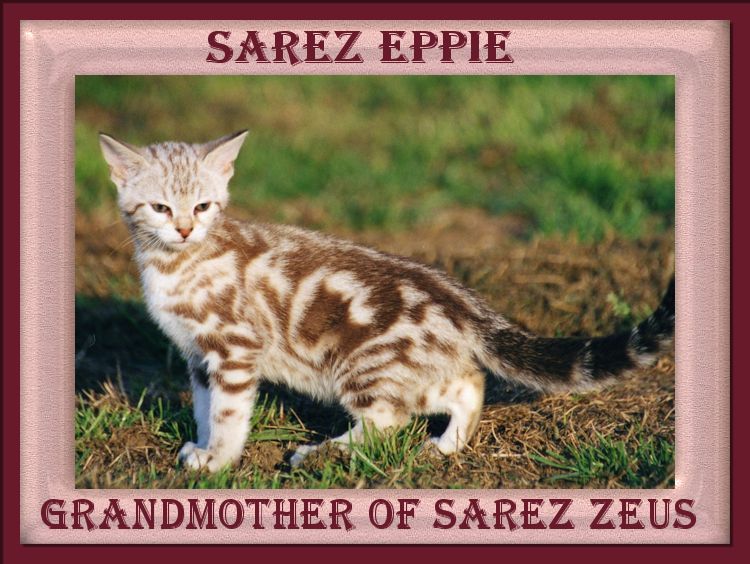
Sarez Eppie, the F2 female in the photo above, is another of Esmond's great achievements and is the grandmother of Sarez Zeus. She is a superb example of a snow marble, having a swirling marble patterned coat with a beautiful pearlescent background that looks as if it's been sprinkled with silver glitter! At the time, even late generation (SBT) snow marbles were incredibly difficult to breed, and Eppie was the first F2 of that colour to be born in Britain.
But Filial 1 (F1) hybrids are the ultimate rarities of the Bengal fancy! And they're also the most captivating and intriguing generation of the Bengal cat. Esmond eloquently describes them in this superb article, 'The Leopard Mimics - F1 and F2 Bengals', opening with the line; "Their beauty is legendary and with elegance that embodies all the grace and poise of a prima ballerina, together with the sophisticated looks of a supermodel, they could easily hold their own on the world's most prestigious catwalks!" Only someone who lived with these cats and witnessed their majesty on a day-to-day basis, could write such an evocative description!
'The Leopard Mimics - F1 and F2 Bengals'. To read it, please click HERE.
Much has been written about whether or not F1s make good pets (mostly it's only non-F1 breeders and owners who claim they don't), but Esmond clarifies his thoughts in the article, saying; "The inexperienced tend to assume that F1s are temperamental and unfriendly, but the contrary is true - the domestic blood mix combined with a lot of handling from kittenhood, normally ensures that they grow up to be as loving and docile as SBTs." In 'The Ultimate F1 Bengal - Sarez Zeus, the World's Most Expensive Cat' (an article that Esmond wrote about Zeus and how he bred him), there's a very interesting letter about this subject, written by the founder of the breed, Jean Mill, after she travelled to the UK and met Esmond's F1s at his home.
'The Ultimate F1 Bengal - Sarez Zeus, the World's Most Expensive Cat'. To read it, please click HERE.
And they're very clever, but also delicate, as Esmond goes on to explain; "F1s are also very intelligent due to the heightened natural instincts they inherited from their wild leopard cat father, and this means they can be more sensitive compared to normal house cats, in the same sort of way that a 4-year-old child is."
And this generation is so rare for a reason! In 'The Leopard Mimics', Esmond writes; "F1 kittens are immensely difficult to breed due to their father, the leopard cat. Like all wild cats, the leopard cat is one of the wonders of Mother Nature - they are remarkably beautiful animals, but one that's no larger than the domestic cat. They are very hard to obtain, and to be conducive to hybridising, they must be hand-reared around domestic cats and never with wild cats. If one can't obtain or breed such a cat and instead attempts to use a wild, parent-reared leopard cat, he simply won't hybridise and if panicked, he could kill or seriously injure a Bengal female. And even if a leopard cat is hand-reared around domestics, only 1 in 15 will hybridise due to their dislike of the domestic smell."
And the following is something I (and probably many others) hadn't realised. Esmond continues; "Female leopard cats should not be used because the resulting F1 offspring have domestic physical features due to the genetics of the process - it is only the male leopard cat who passes down the wild look that Bengals need. And so, with all these factors considered, the odds are greatly stacked against hybridisation taking place."
Esmond wrote a very detailed article about the leopard cat and what it's like sharing ones home with them:
'The Leopard Cat - Founder of the Bengal Breed'. To read it, please click HERE.
And many photos of them (and his ocelots, African leopards, Bengals and his hundreds of rescued animals) can be seen in this positively breath-taking album:
Esmond's Exotic Animals: To see them, please click HERE.
In 'The Leopard Mimics - F1 and F2 Bengals', Esmond writes that; "Once one has reared a leopard cat who is happy to mate with domestic cats, the actual birthing process is relatively straightforward as the mothers of the first generation kittens are normally the easy to handle later generation Bengals. But the F1 babies must still be handled as much as possible to ensure they are very human orientated and affectionate. Due to the hybridisation process, the first three generations of male Bengals are almost always infertile, and they can be re-homed as pets, leaving the fertile early generation females to take the breed forward."
'The Leopard Mimics - F1 and F2 Bengals'. To read it, please click HERE.
In 2000, Esmond became the first and only breeder in the UK to hybridise from the leopard cat, and he succeeded in this difficult feat with not just one leopard cat, but with two! Only a tiny handful of breeders in the world have done this. In the beginning, he bred the UK's first 50% wild blood F1s, but then moved in to breeding the astonishingly rare higher wild blood F1s, something that is much more complex because the mums have to be early generations.
And in July 2001, Esmond's prized snow marble F2, Sarez Eppie, and one of his leopard cats, Sarez Little L., became the proud parents of some remarkable 75% wild blood F1 babies. And as the babies had such stunning wild features, Esmond repeated the mating and in April 2002, Sarez Pow Wow and her brother were born. The image below illustrates the beauty of Sarez Pow Wow.
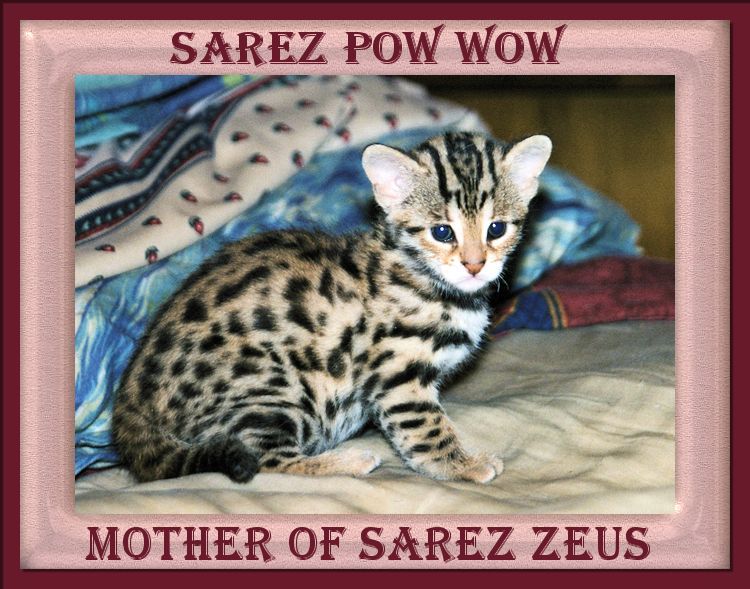
With such high wild blood F1s, it's REALLY important that they grow up with friendly temperaments, and so, using all the experience gained whilst hand-rearing leopard cats, Esmond and his family handled them almost constantly, smothered them with love, and that helped to override their heightened wild instincts.
And in March 2003 Esmond bred Sarez Pow Wow back to the leopard cat and created what is believed to be the world's only 90% wild blood F1 - Sarez Zeus! The hard work, skill, dedication and patience needed to create such a cat, cannot be underestimated, nor can the hundreds of thousands of pounds Esmond invested on breeding him and his forebears. But what a feat! This cat was destined to be a legend from the day he was born!
Pictured below is the adorable Sarez Zeus at the age of four weeks. With rounded ears and beautiful brown eyes, Zeus is a real showstopper!
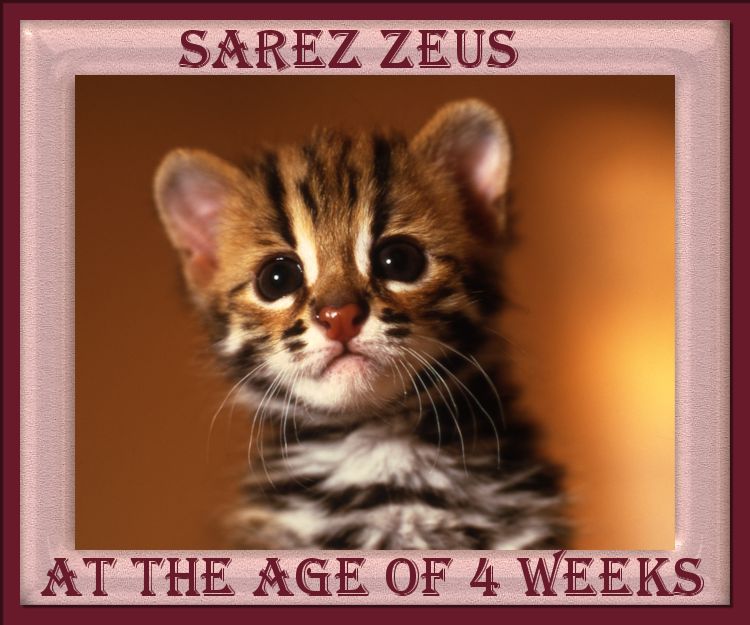
In 'The Ultimate F1 Bengal - Sarez Zeus, the World's Most Expensive Cat'., Esmond explains; "Zeus perfectly encapsulates the wild look of the leopard cat, yet he is overtly friendly and just as docile as a normal domestic cat. Because of his (£100,000) price tag, Zeus became an international sensation, mesmerising both the press and the public alike."
'The Ultimate F1 Bengal - Sarez Zeus, the World's Most Expensive Cat'. To read it, please click HERE.
In the same article Esmond continues; "Some may be surprised at the prices that my fiancée, Sarah, and I ask for our rarest cats such as Sarez Zeus, and indeed, his (£100,000) [$150,000] price was a significant amount of money. But in Britain, F1s have always been costly - anything that's very rare and beautiful always is. In the early to mid 1990s, we bought three of just four F1 Bengals that were in the country, and we paid very high prices for them; we did so because we wanted them, and that meant we had to pay whatever their owner deemed fit."
"And of course, our own huge expenses have to be factored in, including buying exemplary breeding cats, veterinary care, building luxury enclosures, and other running costs of our estate." Esmond states. "We work tirelessly to breed the best and the most unique...felines whose beauty and characteristics are awe-inspiring - and we are immensely proud of our accomplishments".
And he poignantly continues; "A piece of jewellery, an antique vase or even a car number plate, can easily command the same price as Zeus - yet they are all inanimate objects. Yes, they're all attractive in their own rights, but none can become one's companion, none can comfort a person nor make them laugh...and none can love. Yet few query their huge price tags...".
Very true. Zeus seems to encapsulate a little bit of everything that makes something so highly prized; years to create, the rarity of a one-off, the beauty of a dazzling diamond...but with the loving, tender nature of a little child; "a living work of art". In my eyes, a true masterpiece.
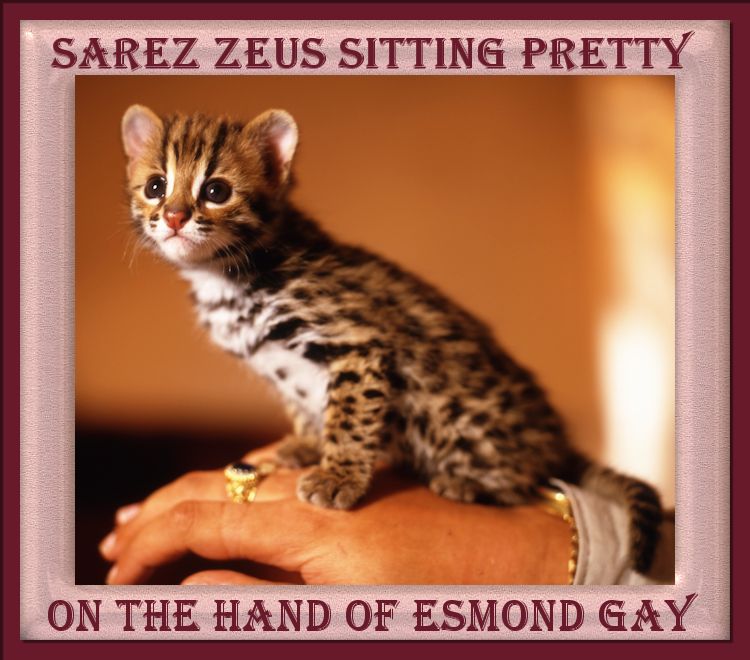
But it isn't just anyone who's allowed to buy one of Esmond's kittens! I was astonished at how in-depth, drawn out and how rigorous his interview process for prospective new owners is, as described in this article: 'Buying, Training and Caring for Bengal Cats'. Yet even with these hurdles, his 'waiting list' was rarely empty. Because his clients recognised and wanted quality.
'Buying, Training and Caring for Bengal Cats'. To read it, please click HERE.
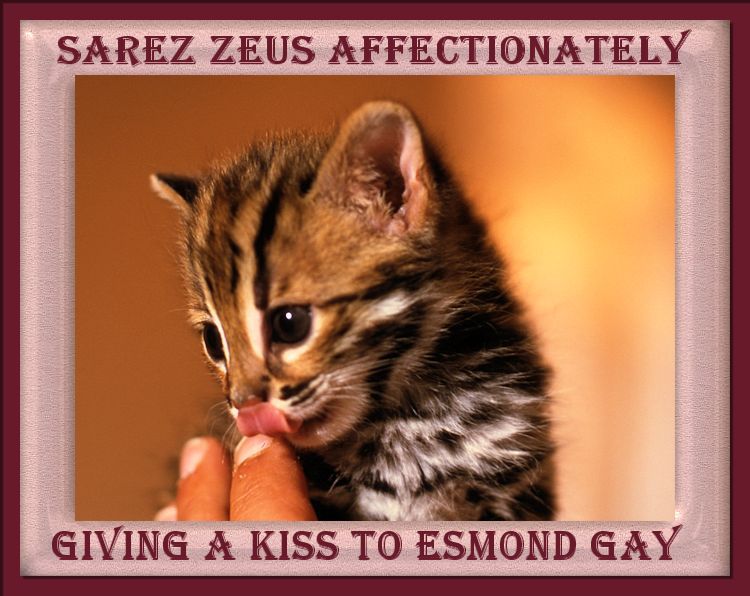
When I look at the photos on this page, I'm not surprised that most who behold Zeus are captivated! As the world's most expensive cat, over the summer of 2003, Zeus appeared in huge features in multiple worldwide newspapers and magazines. And he was on British TV 7 times plus many more in 35 other countries.
Describing these events in the article he wrote about breeding Zeus, Esmond says; "And, ignoring all the cameras and strangers around him, he behaved impeccably on all, playing with my fiancée and young daughter, Kitten Gay, in front of vast audiences. And whilst some of the news features debated his price, others his heritage and his astonishing good looks, all wrote about his gentle and amicable personality. What a superb advocate for the Bengal cat! Zeus proved to millions that as a high wild blood F1 can be trustworthy and loving even when in a stressful situation, then a late generation is surely as docile as a rabbit!"
And over the years, it wasn't only Zeus who advocated the friendliness of the Bengal cat. Since the mid 1990s, many of the other Bengals bred by Esmond Gay became great ambassadors for the breed. All told, they starred on about 35 TV programmes and in over 100 newspapers and magazines (to see them, click: Newspaper and Magazine Articles: and enlarge the photos to read the features):
Newspaper and Magazine Articles: To read them, please click HERE.
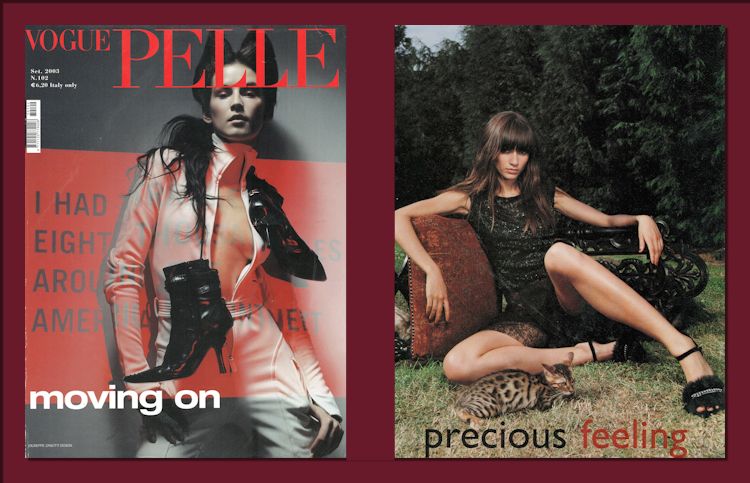
Bengal cats bred by Esmond have also advertised Armani, Versace and Cavalli haute couture in the likes of Vogue Pelle, Tatler and Country Life. His kittens have strolled down fashion catwalks with supermodels and attended gala parties - something that enticed an eclectic mix of royals, stars and celebrities to purchase his kittens. The stars and their stories, plus the gala events are all vividly described in Esmond's article: 'Sarez Bengals...the Cats that Bewitched the Stars'. And it also explains Esmond's spectacular rise in the media from 1994.
'Sarez Bengals...the Cats that Bewitched the Stars'. To read it, please click HERE.
Whilst other photos can be viewed here:
Esmond Gay with Celebrities: To view the images, please click HERE.
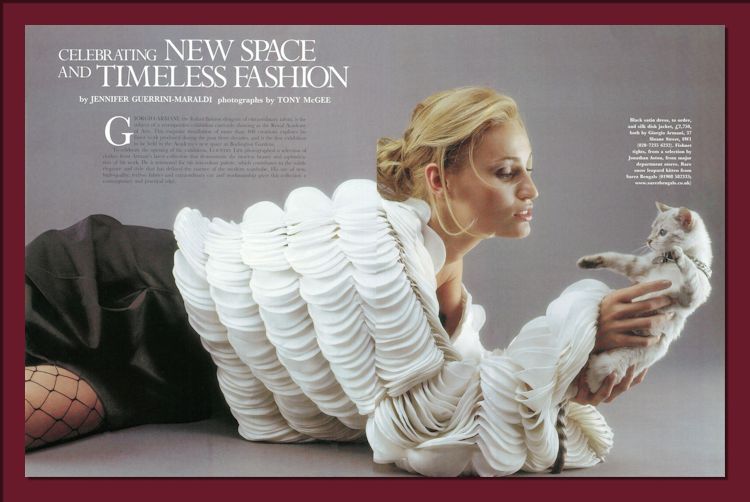
As for Zeus, well, again, I agree with Esmond; "He is as popular today as he was in 2003, as one can see on the Internet". This beautiful cat's uniqueness, his price and the adorable character that shines through on the TV programmes, still captivates the public....so much so that 15 years later, here I am devoting a whole page on my website to a cat that I've never even met!
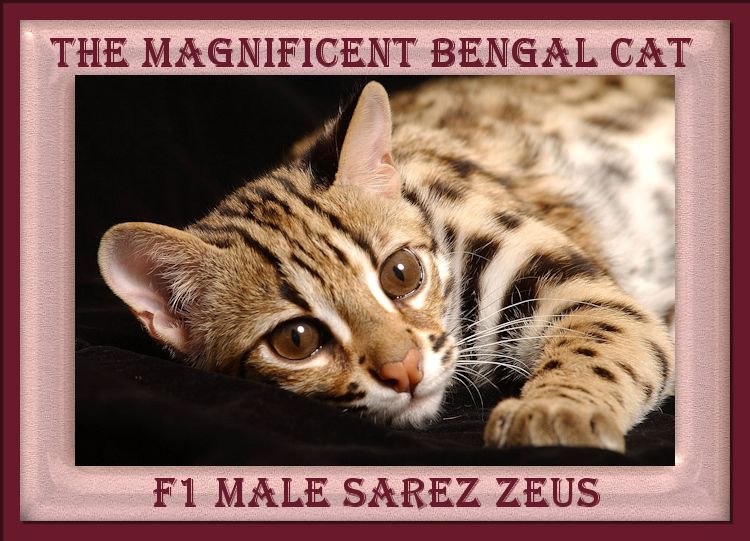
And as for Esmond Gay, well, I've found the man to be a gentle soul, probably too gentle for the viciousness that can exist when one stands out so prominently within the cat fancy. Even back in 1996, a journalist who despised what he was witnessing, graphically described the persecution Esmond suffered at the hands of other breeders, in a huge 5-page national newspaper article. It's a gripping story that you can read here:
'Fur and Loathing'. A 5 page feature. To read it, please click HERE.
Esmond's rise from penniless to multi-millionaire and from obscurity to fame, was meteoric; even though it was over a 10 year period, that's still quite a short time to have accomplished all that he did. He had achieved all of his goals (most of which have not been beaten or even equalled by others to this day), but all these factors created huge stress on an already sensitive man, as did working to his own perfectionist standards. Esmond and his partner decided to get away from all the publicity, from the 'pomp and the circumstance', and to live and work with his 'first love', wild cats, in their natural habitats, and so they retired from pedigree cat breeding in 2004. Esmond lives a very private life and rarely communicates with anyone from the cat fancy.
For much more information about Esmond, his articles and his work with Sarez Bengals, click his name in the left hand menu of my website.
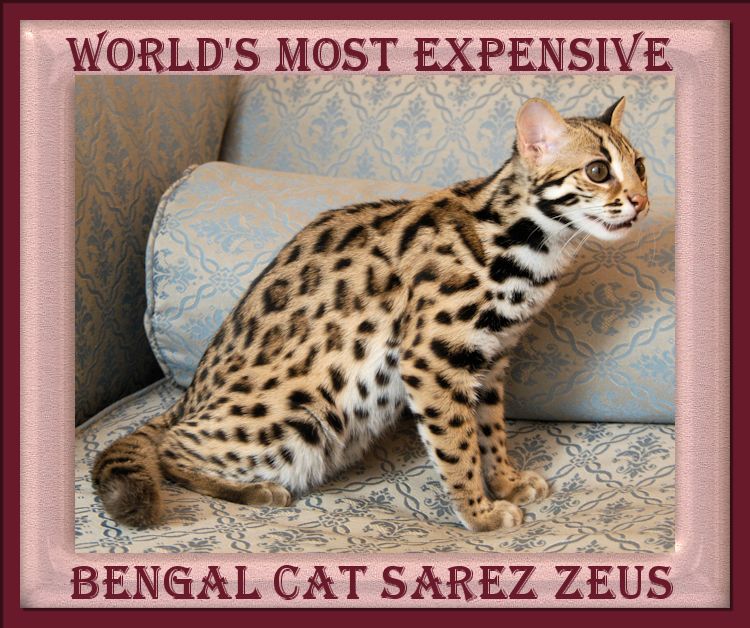
Here are a few links to some of the TV programmes Zeus was on (to view them, click the coloured hyperlinks "Esmond Gay's Interview"):
Esmond Gay's Interview: This is a delightful interview featuring Sarez Zeus. To view the video, please click HERE.
This next TV programme begins with a very accurate description by the presenter; "He's small, he's cute and the best thing about him is he's worth (£100,000)."; Esmond Gay's Interview:
Esmond Gay's Interview: To view the video, please click HERE.
Sarez Zeus is featured again at the age of five months in another charming TV appearance: Esmond Gay's Interview:
Esmond Gay's Interview: To view the video, please click HERE.
And this one is called 'The Mini-Leopard" and was filmed on 27th August 2003.
Esmond Gay's Interview: To view the video, please click HERE.
"How much does he cost and why is he so special?", are the questions asked of Esmond in this Sarez Zeus interview: Esmond Gay's Interview:
Esmond Gay's Interview: To view the video, please click HERE.
Esmond Gay's Interview: In this one, Esmond speaks about Sarez Zeus and how difficult it was breeding the ultimate F1 Bengal.
Esmond Gay's Interview: To view the video, please click HERE.
And on this YouTube channel you'll see nearly 30 interviews and documentaries about Esmond, his Bengals, his ocelots, African leopards, leopard cats as well as all the animals he rescued. There is also a tour of his home and the Sarez cattery:
Esmond's TV Appearances: To watch them, please click HERE.
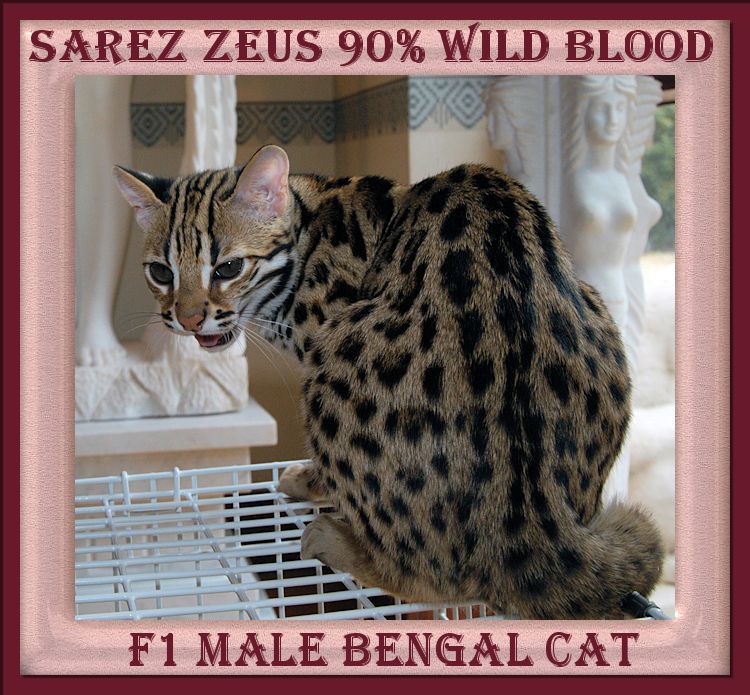
Here's another article Esmond wrote:
'Bald n' Beautiful Sphynx - Our Story'. This article recounts a new adventure for Esmond; breeding Sphynx cats. This charming naked breed are as unusual as the Bengal, but in very different ways.
'Bald n' Beautiful Sphynx - Our Story'. To read it, please click HERE.
And finally, to see the rest of Esmond's other public albums on Facebook:
To see other public albums, please click HERE.
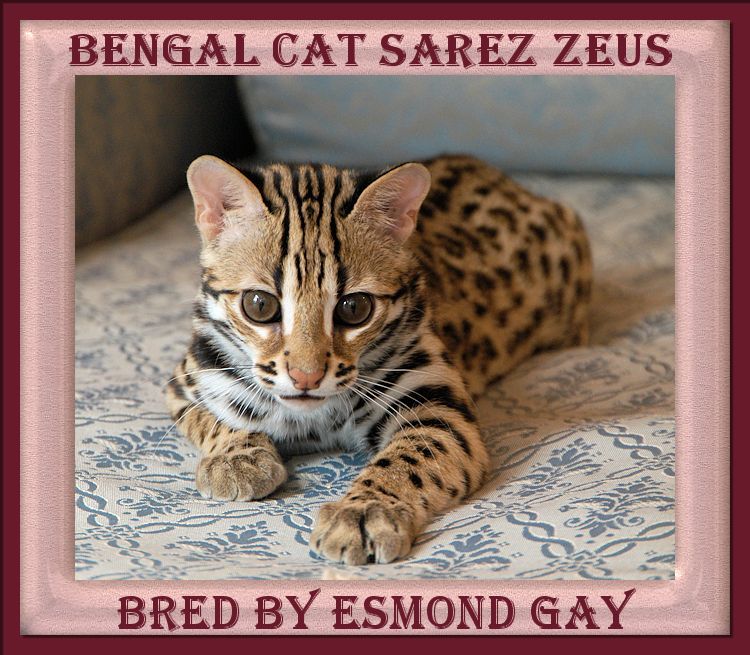
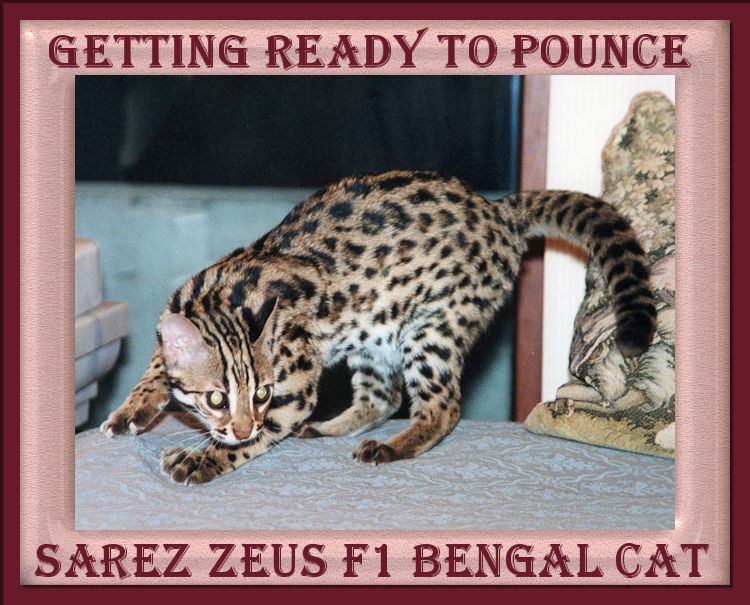
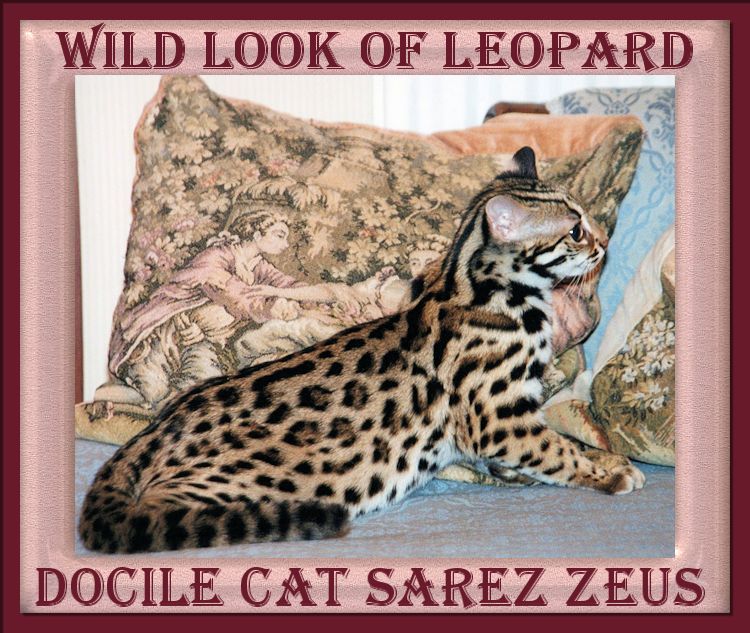
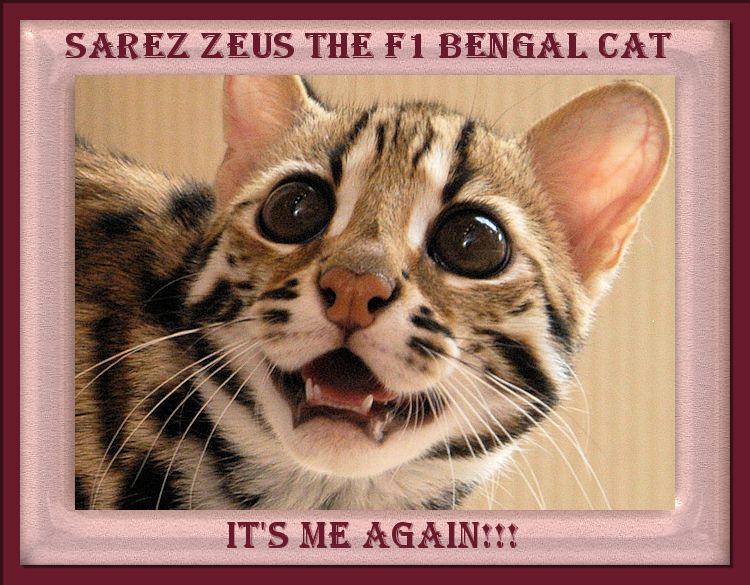
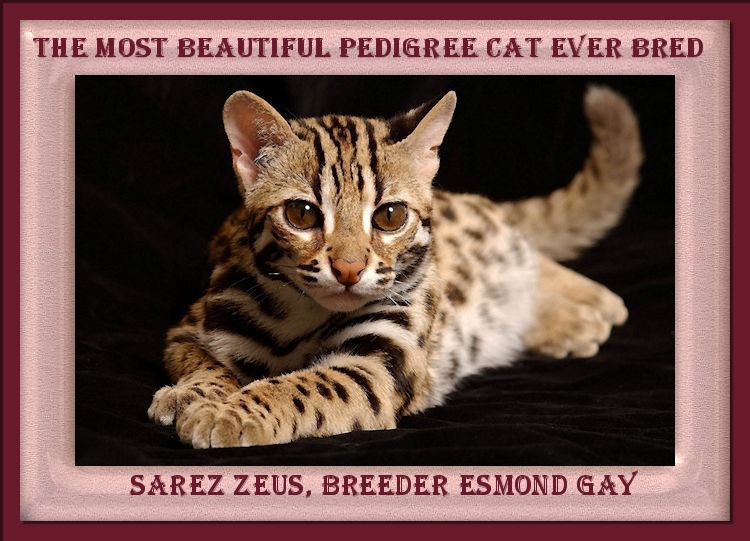
Esmond's daughter, Kitten Gay laughing as she plays with Sarez Zeus.
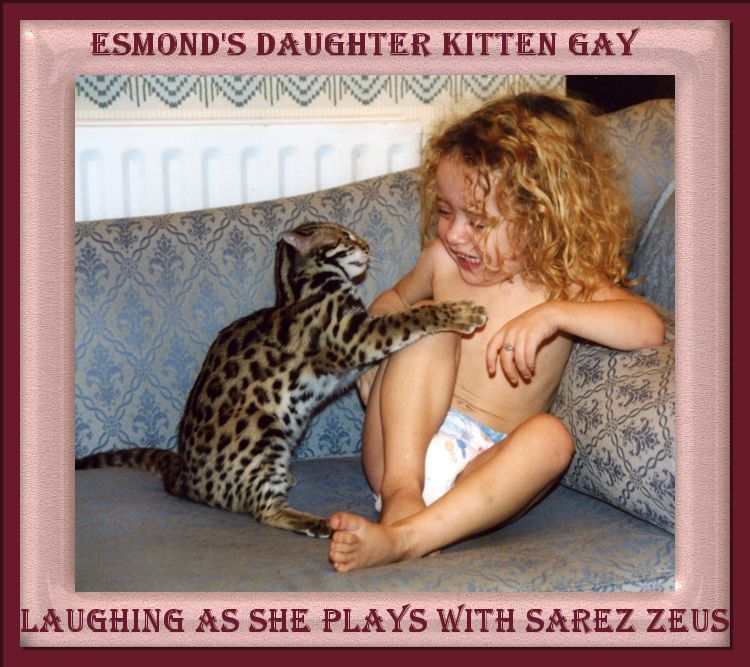
Esmond's daughter, Kitten Gay with the mother of Zeus Sarez Pow Wow.
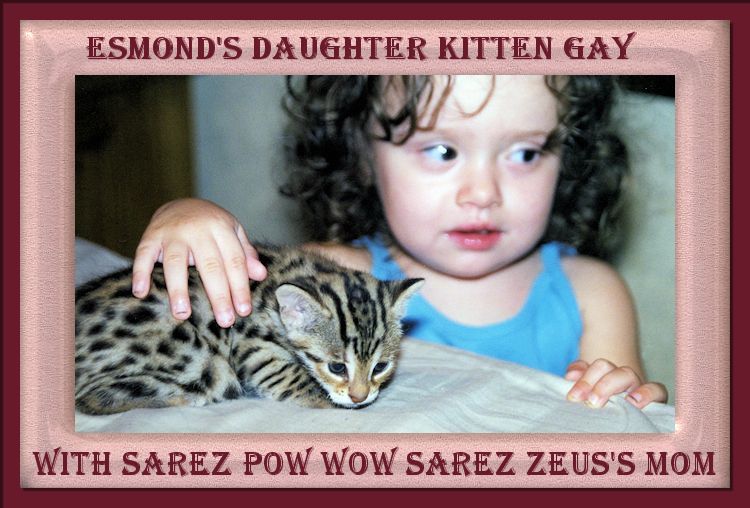
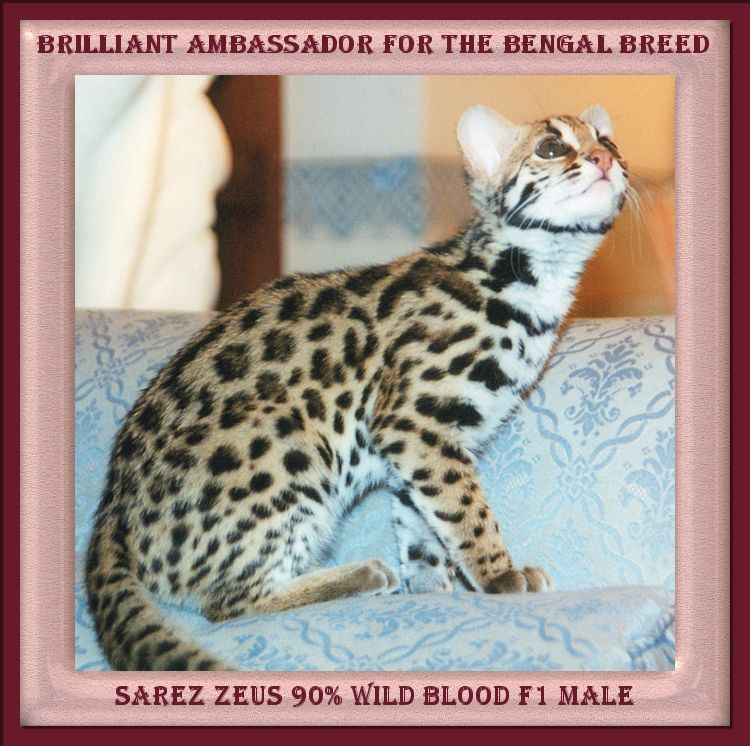
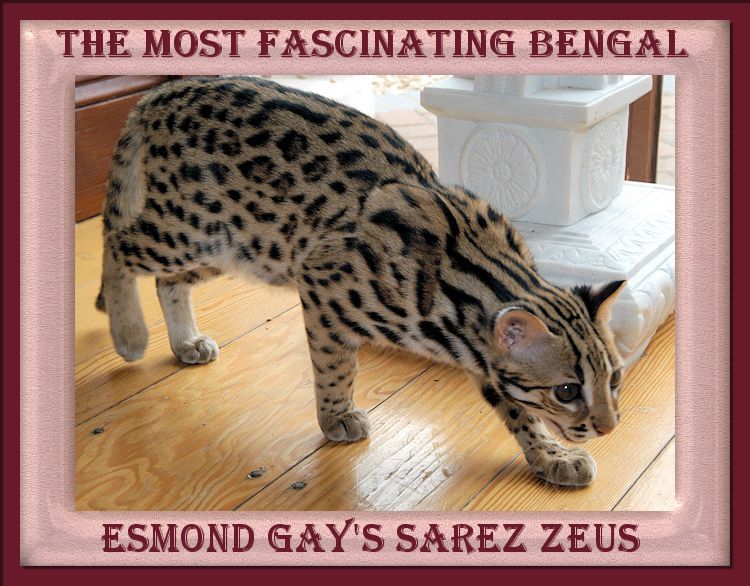
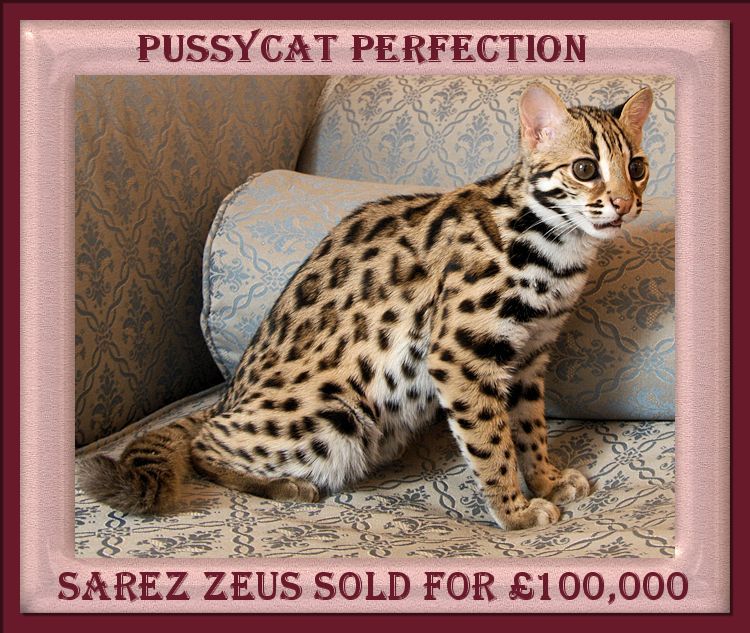
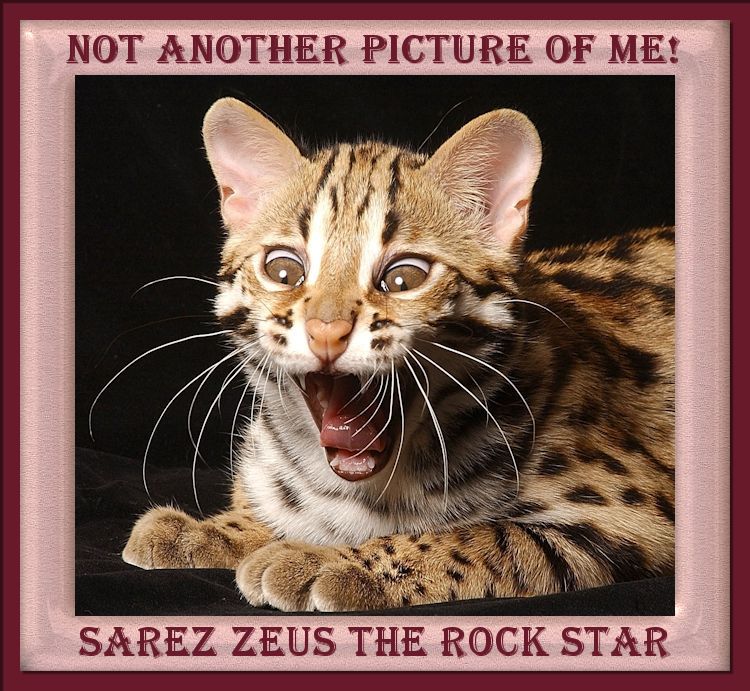
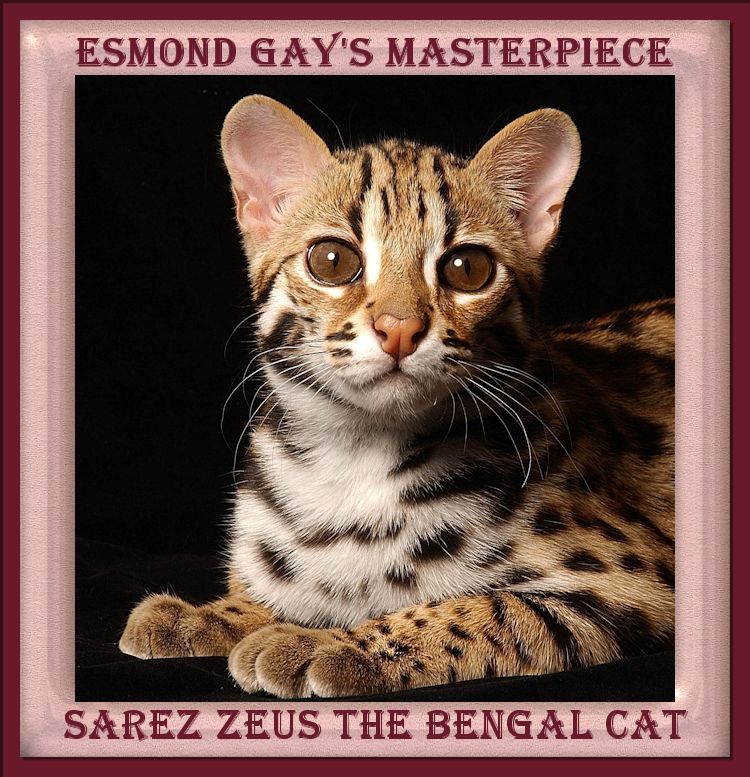
|
|
